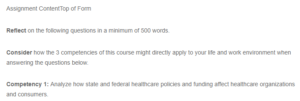Health Sector Policy and Governance
The intersection of healthcare policies, cultural competence, and advocacy strategies forms a dynamic landscape that directly shapes the quality of care provided by healthcare professionals (Mobula et al., 2014). This essay explores the application of three key competencies within the context of a healthcare environment. The relevance of these competencies becomes evident in Question 1, which delves into the imperative of understanding cultural diversity to deliver equitable and effective healthcare. In the complex realm of healthcare, the significance of catering to diverse cultural populations cannot be overstated. As a professional operating within a healthcare organization, I frequently navigate situations where cultural training becomes the linchpin in serving varied populations. Such training equips healthcare providers with the tools to render culturally competent care, thereby enhancing patient outcomes and experiences.
A scenario I encountered underscores this point: a patient hailing from a culturally diverse background exhibited hesitancy in seeking medical treatment due to traditional beliefs and language barriers. By applying the tenets of cultural training, our healthcare team engaged in cross-cultural communication, demonstrating sensitivity to the patient’s beliefs. This approach not only alleviated the patient’s concerns but also nurtured a trusting rapport, facilitating effective medical intervention. This firsthand experience underscored the direct impact of diversity and cultural training on our organization’s capacity to provide patient-centered care.
Expanding the purview to a broader societal perspective, the influence of cultural competency training on healthcare organizations manifests through heightened patient satisfaction, diminished health disparities, and improved health outcomes for diverse populations. When healthcare professionals adeptly navigate cultural nuances, they can tailor treatments to align with patients’ beliefs and preferences, thereby fostering greater patient compliance and improved health trajectories (Mirsu-Paun et al., 2012).
Question 2 evaluates the learning journey in this course, discerning its salient contributions and potential for enhancement. Several assignments and learning activities stood out for their educational potency. Among them, exploring state and federal healthcare policies and their repercussions on healthcare organizations and consumers yielded significant insights. This exploration illuminated the intricate interplay between policy decisions, funding allocation, and their reverberations throughout the healthcare delivery process. Likewise, the exploration of methodologies to address the healthcare needs of diverse populations was another enlightening endeavor. Through case studies and discussions on mitigating healthcare disparities, cultivating cultural competence, and enhancing access to care, my awareness of the unique challenges different population groups face was deepened. This process emphasized the paramount importance of tailoring healthcare services to align with the specific needs of various demographic segments.
To optimize the learning experience, integrating real-world case studies and guest lectures from industry experts would undoubtedly enrich practical insights into how these competencies manifest in diverse healthcare settings. Furthermore, incorporating interactive simulations or role-playing exercises that simulate advocacy scenarios would foster the development of advocacy skills within a realistic context.
In summation, the competencies encapsulated in this course have a direct bearing on both my personal and professional spheres. The nuanced understanding of healthcare policies, cultural competence, and advocacy strategies position me to deliver equitable, high-quality care. By synthesizing these competencies, healthcare organizations can cultivate an environment where every patient’s distinctive needs are comprehended, honored, and addressed. Ultimately, this confluence of knowledge equips professionals to navigate the multifaceted challenges of modern healthcare, fostering better patient experiences and outcomes.
References
Mirsu-Paun, A., Tucker, C. M., & Hardt, N. S. (2012). Medical students’ self-evaluations of their patient-centered cultural sensitivity: Implications for cultural sensitivity/competence training. Journal of the National Medical Association, 104(1–2), 38–45. https://doi.org/10.1016/s0027-9684(15)30127-9
Mobula, L. M., Okoye, M. T., Boulware, L. E., Carson, K. A., Marsteller, J. A., & Cooper, L. A. (2014). Cultural competence and perceptions of community health workers’ effectiveness for reducing health care disparities. Journal of Primary Care & Community Health, 6(1), 10–15. https://doi.org/10.1177/2150131914540917
ORDER A PLAGIARISM-FREE PAPER HERE
We’ll write everything from scratch
Question
Assignment ContentTop of Form
Reflect on the following questions in a minimum of 500 words.
Consider how the 3 competencies of this course might directly apply to your life and work environment when answering the questions below.
Competency 1: Analyze how state and federal healthcare policies and funding affect healthcare organizations and consumers.

Health Sector Policy and Governance
Competency 2: Analyze methods to meet the healthcare needs of various populations.
Competency 3: Analyze advocacy strategies in a healthcare policy context.
Question 1:
Think of a situation in which you must treat various cultural populations at a healthcare organization. How could you utilize diversity and cultural training within your own work environment to better serve these diverse populations? Provide an example, either within your work environment or in society at large, of when this had an impact on the organization.
Question 2:
What specific assignments or learning activities from this course did you find particularly beneficial? What do you feel could’ve improved or added to your learning experience in this course?

